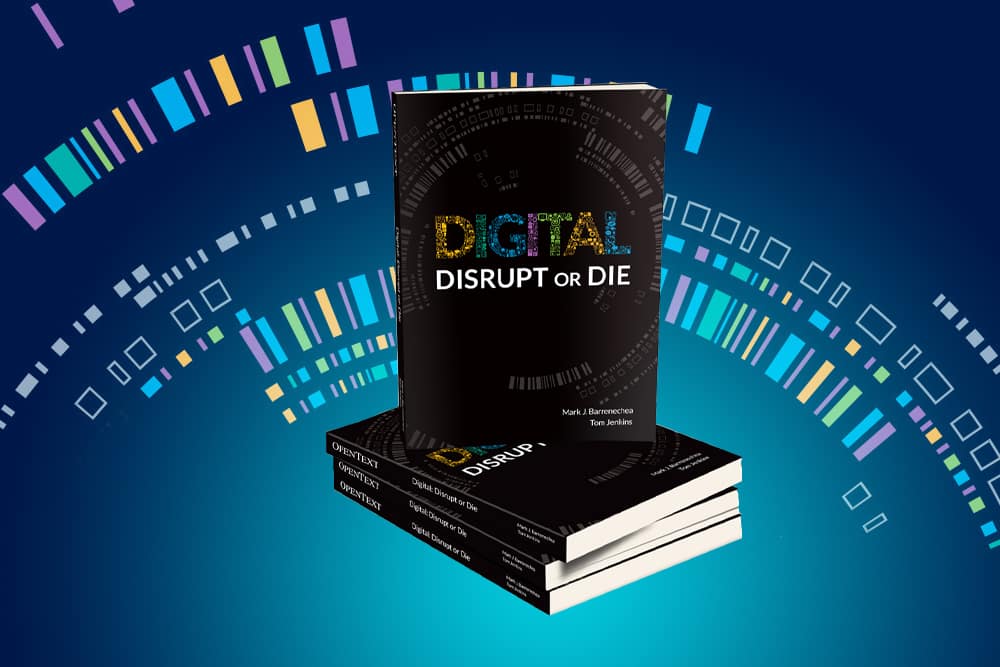Today, I’m happy to kick-off our “Digital-First Fridays,” a new blog series that describes a Digital-First World, provides
strategies for transformation, and shares best practices using real-life examples. The series is based on our recent book, Digital: Disrupt or Die, authored by myself and OpenText Chairman, Tom Jenkins.
In every sector, digital technologies are changing the rules of business. Startups and web-based companies are using digital business models to disintermediate the established market leaders. To remain relevant in a Digital-First World and gain a sustainable competitive advantage, organizations will be required to transform themselves into digital enterprises. Digital transformation requires a radical overhaul of enterprise strategies, processes, products, services, and relationships. Enterprise Information Management (EIM) empowers organizations to make this journey. How? At a basic level, it guides them through each phase of transformation, giving them effective ways to simplify, transform, and accelerate their business.
1. Simplify. Every organization wants to simplify its business. This is a constant challenge. Part of being a digital enterprise involves digitizing your information and automating your processes. In a Digital-First World, you can expect all of your business’ processes to be digitized. Automation will be critical—new research shows that nearly half of all jobs over the next two years could be automated.(1) As business evolves, we’ll rely more and more on machine-based or artificial intelligence, sensors, pattern analysis, and connections between all of these, brought together by the Internet of Things (IoT). Most organizations are already working toward simplifying their operations, indicated on the diagram below as “Present Day Followers.”
2. Transform. Business processes need to be agile to adapt products, services, and operations as customer expectations change—and they are changing. This requires transforming information-based processes and platforms to support digital consumers, a new workforce, a digital supply chain, and emerging technologies. To do this effectively, organizations will need to create an environment in which innovation thrives. Business and technology leaders should be ready to take risks, lead digital strategies, and define new models of engagement. Be ready for a substantial shift in culture to one that’s built on openness, innovation, and trust. Business problems should be examined and new processes created to solve them fearlessly and with imagination. If your organization is here, it’s already adapting to the requirements for future digitization.

3. Accelerate. This describes the rate at which we must undertake these changes, which may be daunting to some but, at the same time, it presents greater opportunities to serve customers, partners, and suppliers. Every organization will be required to rethink the way they’re engaging with customers, how they facilitate the workforce, and the ways they’re integrating and managing their information. The final phase of transformation relies on constant innovation. This can only be achieved by increasing the speed of information delivery through integrated systems. Digital Leaders have mastered this. They’re already redesigning customer experiences, overhauling their approaches to information management, rethinking their processes, and re-platforming their operations.
Information lies at the heart of digital transformation. Its potential—if realized—is transformative. The challenge lies in managing enterprise information, making it accessible, and then applying it in new ways. EIM is the key transformative technology. Throughout the phases of digital transformation, a digital enterprise adopts EIM as its foundational enterprise platform for change.
On “Digital-First Fridays” we’ll explore the future of digital technologies, their impact on the enterprise, and demonstrate how EIM equips the enterprise to brace for change in a Digital-First Future.
Posts in the series will include:
- Operating at the Speed of Digital
- What is a Digital Enterprise?
- Information is the New Currency
- Digital Engagement—A New
Business Requirement - The Digital Supply Network
Be sure to bookmark this page and join in the conversation.
(1) David R. Wheeler, “Silicon Valley to millennials: Drop dead,” CNN, March 18, 2015, http://us.cnn.com/2015/03/18/opinions/wheeler-silicon-valley-jobs/?iid=ob_article_organicsidebar_expansion&iref=obnetwork (accessed April 2015).




